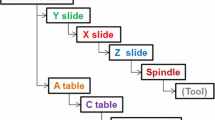Abstract
Developing PLC software for modern machine tools is becoming more difficult because of the increasing functionality and resulting complexity. An approach for managing this is provided by the model-driven development of the control software. However, this innovative development method requires both a procedure that is adapted to the specific application domain and suitable modeling techniques. The article describes an approach appropriate for machine tools. The focus is on introducing the necessary description techniques and a methodology for their use in product development.








Similar content being viewed by others
References
Weck M, Brecher C (2005) Werkzeugmaschinen—automatisierung von maschinen und anlagen, 6th edn. Springer, Berlin
Gausemeier J, Lindemann U, Reinhart G (2000) Kooperatives produktengineering. Bonifatius, Paderborn
Gewald N, Mikk E (2003) Ein industrielles wiederverwendungskonzept für IEC 61131-3 auf der basis von UML. Atp—Automatisierungstechnische Praxis 45(6):59–68
Bundesministerium für bildung und forschung BMBF (ed) (2005) Positionspapier—forschungs-und handlungsbedarf für zuverlässige mechatronische systeme. Forschungszentrum karlsruhe, Karlsruhe
Kent S (2002) Model driven engineering. In: Buttler M (ed) Proceedings of the 3rd international conference on integrated formal methods, Turku (Finland). Springer, Berlin
Rugaber S, Stirewalt K (2004) Model-driven reverse engineering. IEEE Softw 21(4):45–53
Schlingloff H, Conrad M, Dörr H, Sühl C (2004) Modellbasierte steuerungsgeräteentwicklung für den automobilbereich. In: Plöderer E (ed) Automotive—safety & security 2004—Sicherheit und Zuverlässigkeit für automobile Informationstechnik, Stuttgart. Shaker, Aachen
Fischer K, Vogel-Heuser B (2002) UML in der automatisierungstechnischen Anwendung—Stärken und Schwächen. Atp—Automatisierungstechnische Praxis 44(10):3–69
Stahl T, Voelter M (2005) Modellgetriebene softwareentwicklung—techniken, engineering, management, 1st edn. dPunkt, Heidelberg
Zeigler BP, Praehofer H, Kim TG (2005) Theory of modeling and simulation—integrating discrete event and continuous complex dynamic systems, 2nd edn. Academic Press, Amsterdam
Selic B (1998) Using UML for modeling complex real-time systems. In: Mueller F, Bestravos A (eds) Languages, compilers and tools for embedded systems, Montreal. Springer, Berlin
Object management group: UML superstructure specification—version 2.0. <http://www.omg.org/docs/formal/05–07-04.pdf> (15th February 2007)
Weilkiens T (2006) Systems engineering mit SysML/UML—modellierung, analyse, design. dPunkt, Heidelberg
Object management group: systems modeling language specification—version 1.0. <http://www.omg.org/docs/ptc/06-05-04.pdf> (15th February 2007)
Engell S, Frehse G, Schnieder E (2002) Modelling, analysis, and design of hybrid systems. Springer, Berlin
Henzinger TA (1996) The theory of hybrid automata. In: Proceedings of the 11th annual IEEE symposium on logic in computer science, Los Alamitos (CA). IEEE Press, New Brunswick (NJ)
IEC 61131-3: programmable controllers—Part 3: programming languages. Beuth, Berlin (2004)
Object management group: model driven architecture guide—version 1.0.1. <http://www.omg.org/docs/omg/03-06-01.pdf> (15th February 2007)
Braatz A (2003) From model to code—generation of PLC software from UML. In: Schraft RD, Brandenburg G, Bender K, Hoepf M (eds) SPS/IPC/DRIVES, Nuremberg. VDE-Verlag, Berlin
Zaeh MF, Ehrenstrasser M, Poernbacher C, Wuensch G Emerging virtual machine tools. In: Shimada K (ed) Design automation conference, ASME design engineering technical conferences, paper no. DETC2003/DAC-48756
Zaeh MF, Poernbacher C (2005) A Model-based method to develop PLC software for machine tools. Ann CIRP 54(1):371–374
Author information
Authors and Affiliations
Corresponding author
Rights and permissions
About this article
Cite this article
Zaeh, M.F., Poernbacher, C. Model-driven development of PLC software for machine tools. Prod. Eng. Res. Devel. 2, 39–46 (2008). https://doi.org/10.1007/s11740-008-0083-7
Received:
Accepted:
Published:
Issue Date:
DOI: https://doi.org/10.1007/s11740-008-0083-7




